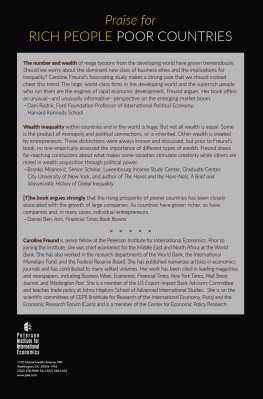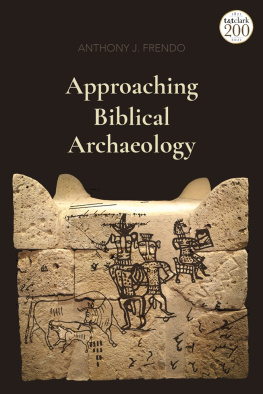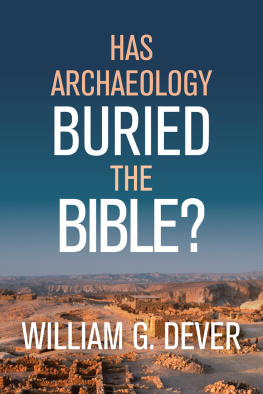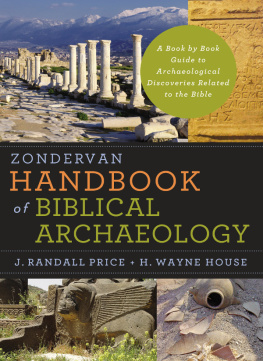DIGGING THROUGH
THE BIBLE

Map of the Holy Land.
DIGGING THROUGH
THE BIBLE
UNDERSTANDING BIBLICAL PEOPLE,
PLACES, AND CONTROVERSIES
THROUGH ARCHAEOLOGY
RICHARD A. FREUND

ROWMAN & LITTLEFIELD PUBLISHERS, INC.
Published in the United States of America
by Rowman & Littlefield Publishers, Inc.
A wholly owned subsidiary of The Rowman & Littlefield Publishing Group, Inc.
4501 Forbes Boulevard, Suite 200, Lanham, Maryland 20706
www.rowmanlittlefield.com
Estover Road
Plymouth PL6 7PY
United Kingdom
Copyright 2009 by Rowman & Littlefield Publishers, Inc.
All rights reserved. No part of this publication may be reproduced, stored in a retrieval system, or transmitted in any form or by any means, electronic, mechanical, photocopying, recording, or otherwise, without the prior permission of the publisher.
British Library Cataloguing in Publication Information Available
Library of Congress Cataloging-in-Publication Data
Freund, Richard A.
Digging through the Bible : understanding biblical people, places, and controversies through archaeology / Richard A. Freund.
p. cm.
Includes bibliographical references and index.
ISBN-13: 978-0-7425-4644-8 (cloth : alk. paper)
ISBN-10: 0-7425-4644-6 (cloth : alk. paper)
eISBN-13: 978-0-7425-6349-0
eISBN-10: 0-7425-6349-9
1. BibleAntiquities. 2. BibleEvidences, authority, etc. 3. BibleHistory of Biblical events. 4. PalestineHistoryTo 70 A.D. I. Title.
BS621.F736 2009
220.93dc22
2008018594
Printed in the United States of America
 The paper used in this publication meets the minimum requirements of American National Standard for Information SciencesPermanence of Paper for Printed Library Materials, ANSI/NISO Z39.48-1992.
The paper used in this publication meets the minimum requirements of American National Standard for Information SciencesPermanence of Paper for Printed Library Materials, ANSI/NISO Z39.48-1992.
contents
Chronology of Events
55004500 BCE | Neolithic (Stone) Age. Pottery was introduced |
45003200 BCE | 1. Chalcolithic (Copper) Age. Copper and flint used
2. Writing developed in Mesopotamia |
30002700 BCE | 3. First and Second Dynasties of the Egyptian Kingdom |
32001200 BCE | 4. Bronze Age (Early, Middle and Late) |
1200586 BCE | 5. Iron Age (From the Exodus from Egypt until the destruction of the First Temple by the Babylonians in 586 BCE) |
586539 BCE | Babylonian Exile |
546333 BCE | Persian Period |
33263 BCE | Greek Period |
63 BCE325 CE | Roman Period |
325638 CE | Byzantine Period |
6381096 CE | Early Muslim Period |
11001200 CE | Crusader Period |
12001517 CE | Later Muslim Period (Mamluke) |
15171917 CE | Ottoman Empire Period |
19171948 CE | British Mandate Period |
1948Present | Modern Israel Period |
The History of Ancient, Medieval, and Modern Israel
18001500 BCE: | 1. Matriarchs and Patriarchs
2. Abraham in Mesopotamia
3. 16481540 BCE Hyksos rule Egypt |
13001200 BCE: | 1. Traditional date of the Exodus from Egypt, Moses, Conquest of Canaan
2. 10201000 BCE Saul, First King of Israel |
1000922 BCE: | 1. United Monarchy of David and Solomon-Building of the First Temple by Solomon. After the death of Solomon, Israel is divided into two parts; Northern Kingdom of 10 tribes and 2.5 tribes in the Southern Kingdom (including Jerusalem).
2. Rehoboam, King of Judah (Southern Kingdom) and Jeroboam I, King of Israel (Northern Kingdom) |
600500 BCE: | 1. Fall of Jerusalem, Destruction of First (Solomonic) Temple by Babylonian King Nebuchadnezzar and Babylonian Exile of the Judeans to Babylon (587/6 BCE)
2. Cyrus the Greats Persian Conquest of Babylon (539 BCE) and return of some exiles from Babylon |
500400 BCE: | 1. Editing of Hebrew Bible
2. Rebuilding of Temple completed 515 BCE
3. Ezra arrives 445 CE |
400300 BCE: | 1. Alexander the Greats (Greek) Conquests (333323 BCE)
2. After Alexander the Greats Death, divided Greek kingdom: Ptolemy I, Greek King of South (Egypt and Judea) and Seleucus, Greek King of North and Eastern (Babylon) part of the kingdom |
300 BCE70 CE: | 1. Hellenistic/Greco-Roman Period
2. Septuagint-Greek translation of the Hebrew Bible (250 BCE)
3. Jerusalem becomes a Greek Seleucid city and renamed Antiochia (172 BCE)
4. The Maccabean Revolt Against the Seleucid Greek King, Antiochus Epiphanes IV (164 BCE)
5. Hasmonean Jewish Rulers: Judah Maccabee (166160 BCE)
6. John Hyrcanus I (135104 BCE)
7. Alexandra Salome, Queen of Judea (7667 BCE). In 63 BCE, Pompey, a general of the Roman army, marches into Jerusalem and establishes Roman hegemony in Judea
8. Herod the Great (374 BCE). The four sects of the Jews: Pharisees, Sadducees, Essenes, and Zealots contend for authority in Judaism. Essenes are associated with the site of Qumran on the Dead Sea. Zealots later become the nationalist, military party that urges freedom from the Romans
9. Jesus of Nazareth (6 BCE30 CE?) and his movement of Apostles |
10. Herods Kingdom divided among his sons, Archeleus in Judea (4 BCE6 CE), Antipas in Galilee (4 BCE39 CE), and Philip in Ituraea and Golan 4 BCE34 CE)
11. Roman Empire. Emperors of Rome: August Caesar (27 BCE14 CE), Tiberius (1437 CE) Nero (5468 CE), Vespasian (6979 CE), and Titus (7981 CE)
Procurators ruling Judea, 641 CE: Pontius Pilate (2636 CE) 12. Pauls travels and death (50early 60s CE)
13. The First Jewish Revolt against Rome begins in Galilee (6673 CE). The last battle is traditionally seen as the capture of Masada in 73 CE
14. Qumran is destroyed by Romans as they proceed to Jerusalem (68 CE). The Dead Sea Scrolls are placed in the caves around Qumran
15. Destruction of Second Temple of Jerusalem (70 CE). Rabbi Yohanan Ben Zakkai begins a new movement of Rabbis at Yavne
16. Written accounts of Jesus life and teachings and the Writing of the New Testament (Gospels according to MarkJohn: 70100 CE?)
17. Rise of Rabbinic Judaism |
18. Writings of Philo of Alexander (Egypt) and Josephus Flavius (Rome) |
100200 CE: | 1. Rise of Christianity
2. The Sanhedrin and the Rabbinic academy meets in Yavne (70 CE), later moves to Lod, Usha, Shefaram, Bet Shearim, Sepphoris, and finally to Tiberias in Galilee after the Second Revolt against Rome, the Bar Kokhba Revolt. The Mishnah, the earliest Rabbinic corpus, is edited by Rabbi Judah HaNasi (the Prince) at Sepphoris
3. Trajan, Emperor of Rome (98117 CE), conquers the Nabateans. Jewish Revolt in Babylon and Judea put down by Trajans General Lucius Quietus (115 CE)
4. Hadrian, Emperor of Rome (117138 CE)
5. The Second Revolt against Rome: The Bar Kokhba Rebellion (132135 CE)
|
Next page














 The paper used in this publication meets the minimum requirements of American National Standard for Information SciencesPermanence of Paper for Printed Library Materials, ANSI/NISO Z39.48-1992.
The paper used in this publication meets the minimum requirements of American National Standard for Information SciencesPermanence of Paper for Printed Library Materials, ANSI/NISO Z39.48-1992.